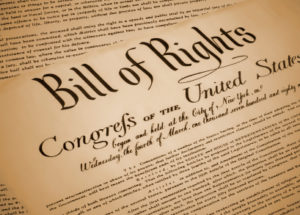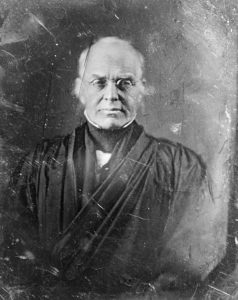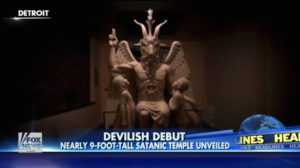Apr
11
A Controversial View on Freedom of Religion
The issue of “religious rights” and the “free exercise of religion” is a contentious one in the United States. (And elsewhere, of course.) It boils down to “Who is allowed to do what?” and “Who decides?”

Naturally, the First and Fourteenth Amendments come up, as does the fan-favorite “separation of church and state”. Incidentally, that phrase is a slight modification of what Thomas Jefferson said in a letter to the Danbury Baptists of Connecticut on Jan. 1, 1802. At the time, several of the former colonies had state-established religions (i.e., Christian denominations), and the Baptists were being persecuted for not being Congregationalists. They had concerns about persecution at a national level, too. President Jefferson told the Baptists that the First Amendment built “a wall of separation between Church and State”, thereby assuring them that the federal government (i.e., Congress) could not constitutionally interfere with their church or offer special favors to any particular sect.
The context is helpful in understanding what Jefferson meant by using that terminology. But, there are many related questions that come up in the larger discussion. For example, “Are state governments required by the Constitution to allow statues, memorials, etc., from any and all religions on government grounds and in government buildings?” I remembered having read an article a few years ago in which the often-controversial Bryan Fischer presented his view on this. I tracked down an archived copy, and I’d like to present a good chunk of it for your consideration:
. . .
The Constitution is like the Bible. It either means what its authors intended it to mean, or it can mean anything the fevered imaginations of activist judges can dream up.
Judges routinely undermine the plain meaning of the Constitution and use linguistic sleight of hand to conceal their subterfuge. For instance, they substitute the word “expression” for “speech,” and voila, pornography magically receives entirely bogus constitutional protection.
Courts have done the same with the word “religion.” That word, as found in the First Amendment, either means what the Founders intended it to mean or it can mean anything.

When the Founders used the word “religion,” they were referring to the various denominations of Christianity. The population of the United States at the time of the founding was 99.8% Christian [or, “Christian-ish”] and 0.2% Jewish. There were simply no other religious traditions for the Founders even to deal with.
As Joseph Story makes clear, in the First Amendment the Founders were dealing exclusively with Christianity. Story was the longest serving associate justice in Supreme Court history, was appointed to the bench by James Madison, the father of the Constitution, and wrote a monumental and authoritative history of the Constitution.
Here’s how he describes what the goal of the Founders was in crafting the First Amendment (emphasis mine):
“The real object of the First Amendment was not to countenance, much less to advance Mohammedanism, or Judaism, or infidelity, by prostrating Christianity, but to exclude all rivalry among Christian sects and to prevent any national ecclesiastical establishment which should give to a hierarchy the exclusive patronage of the national government.”
The Founders did not either “countenance” or “advance” religious alternatives to Christianity in the First Amendment. They were not even considering Islam or Judaism or Buddhism or Hinduism or atheism. They were dealing exclusively with Christianity and its various denominations.
The purpose of the First Amendment was to prevent Congress from picking one Christian “sect” – we use the word “denomination” today – and make it the established church of the fledgling nation. Then, secondly, the aim of the First Amendment was to prevent Congress from interfering with the free exercise of the Christian religion anywhere in the new nation.

So Satanism was neither affirmed nor rejected under the First Amendment for the simple reason that Satanism, like every other one of the world’s alternative religions, was simply not under discussion at all.
So the Constitution, if we are using the one given to us by the Founders and not the one mangled beyond recognition by the courts, provides no cover for satanism.
So who would have authority to decide whether satanic statues find a place in our state capitols? The Founders made that likewise crystal clear. The First Amendment is intended to bind only the actions of “Congress.” “Congress shall make no law…” The only entity that is restrained in any way by the First Amendment is Congress and by extension, the entire federal government, including the judiciary.
So whose call would it be? That would be, under the Founders’ constitution, a matter for the states.
As Story put it (emphasis mine),
“[T]he whole power over the subject of religion is left exclusively to the State governments, to be acted upon according to their own sense of justice and the State constitutions.”
Thus the Founders granted unrestricted authority to regulate religious expression to the states, which is why nine or 10 of them had officially established churches at the time of the founding.
The Founders gave no authority to the central government, including the judiciary, to regulate religious expression at all. The central government is flatly prohibited by the Founders’ constitution from interfering with the free exercise of Christianity in any way anywhere in the United States. Religious expression under the Founders’ constitution is entirely under the authority of the individual states.
. . .
You may (like me) object to several of Fischer’s other views, claims, and characterizations, but he does raise some interesting questions about the Founding Fathers’ collective intent about religious freedom in the U.S. In my opinion, assuming no important facts have been omitted, his contention here does appear to be correct. (Even if the implications makes me a little uncomfortable.) If he is correct, the Fourteenth Amendment and various legal decisions based on it would need a serious reassessment. What do you think?















